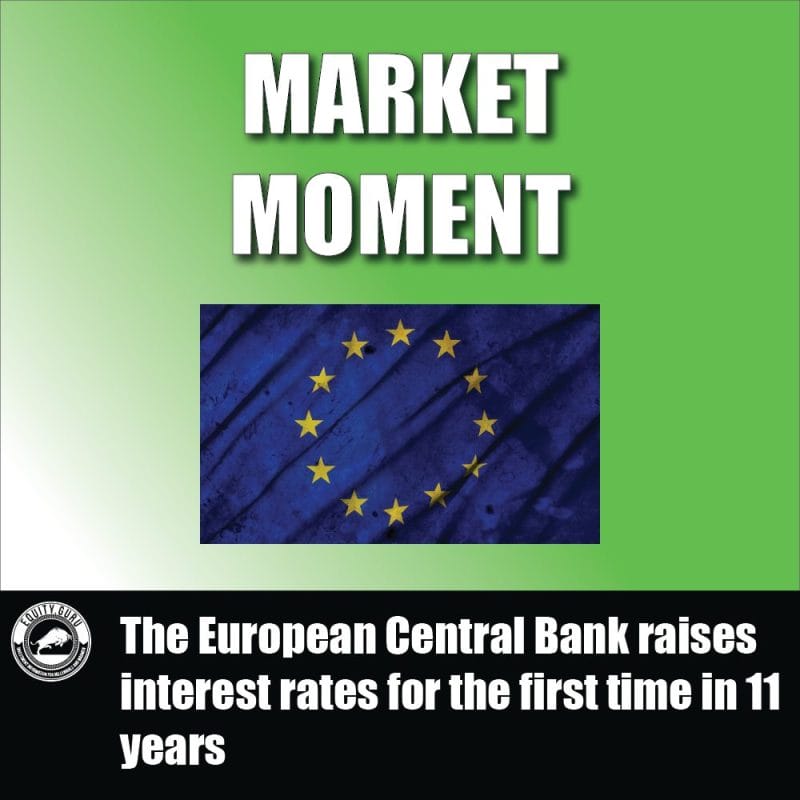The European Central Bank (ECB) raised interest rates for the first time in 11 years. The market expected this as the ECB has been signaling a July rate hike for some time. What the market wasn’t expecting was a larger-than-expected rate hike coming from the ECB. But surprise they did. The ECB raised rates by 50 basis points and not the 25 basis points as expected. This takes Euro zone rates from -50% to a flat 0%.
The ECB took rates into negative territory back in 2014. We finally leave negative nominal rates behind in 2022.
Now what to make of all of this? Spoiler: it isn’t something to celebrate.
With other western central banks already hiking. and some already over 2%, the ECB is definitely late to the party. Perhaps even too late.
With signs of a recession coming, many traders and analysts believe the ECB has a small window to raise rates. The 50 basis point hike is rather seen as a desperation move in order to raise rates as much as possible before this window closes.
Seema Shah, chief strategist at Principal Global Investors, sums the ECB situation up quite nicely:
“The ECB is hiking into a drastically slowing economy, facing a severe stagflationary [when inflation is high and growth is low] shock that is quite beyond its control, while also facing an Italian political crisis which presents a difficult sovereign risk dilemma,” she said, adding “there is no other developed market Central Bank in a worse position than the ECB.”
My outlook is similar. Europe is not in for a good time.
With surging inflation, the ECB is way behind the curve. They won’t be able to raise rates fast enough to tame inflation. If they do, raising rates to levels required would break some European countries…even fracture the Euro zone itself. The ECB is really hoping a recession will be enough to kill demand.
I also highlighted Italy because I think this is crucial. Last month, I notified readers regarding bond yields in Italy. It was freaking the world out and the ECB had an emergency meeting to deal with it. This actually raised some doubts of a larger rate hike by the ECB which is why the 50 basis point hike comes in as a surprise.
Some sort of tool was going to be unveiled, and we got it. The ECB introduced the Transmission Protection Instrument (TPI). You can read the ECB statement here and try to make out the economic jargon. Or I can summarize it for you in simple terms: unlimited bond buying to keep rates low. But don’t call it quantitative easing!

Italian yields hit levels near 4.4% last month. We have fallen to 3.4% but the yield remains resilient. We really need to break below 3.20% in order to say with a high degree of certainty that Italian yields will be dropping rather than popping.
What adds to the drama is the fact the Italian government has broken. Draghi’s coalition has failed and the ex head of the ECB has resigned as the Italian Prime Minister. An election will take place on September 25th.
This just adds to the political instability… and could provide a reason for Italian yields to rise. Keep an eye on this, especially after the election results. When the ECB tests out their new TPI tool, it will be in Italy. And that’s just assuming they already aren’t using TPI right now. The ECB could very well be.
You can probably tell I am not too bullish on Europe. Potential energy problems and food problems come Fall, rising inflation with a central bank that has a small window to raise interest rates as the economy weakens, political situations in Italy and likely to appear in other Euro Zone nations… it doesn’t look too good. I am sure the ECB knows this, hence why TPI. I don’t think Europe will be able to handle high interest rates. Something will break. Or the people will break. Watch those PIIGS nations (Portugal, Italy, Ireland, Greece and Spain).
I believe others see this too. The way I am going to gauge this going forward is by looking at EURJPY.

The Yen has gotten clapped. It is the worst performing currency of the year besides the Turkish Lira. The Bank of Japan is not raising interest rates and is keeping rates negative. This is happening even as the Swiss National Bank and the European Central Bank raise interest rates. Japan isn’t budging.
Believe it or not, but we are actually now in a period where the Euro is yielding more than the Yen when it comes to interest rate differentials between the two nations. It isn’t by much, but this has not happened in a long time.
From this perspective, we should expect to see money flow into the higher yielding currency, in this case the Euro. Perhaps this has already been priced in along time ago hence why the incredible rise in the Euro vs the Yen.
But I am interested to see future price action. Will money still run into the Yen vs the Euro? Maybe people would rather hold Yen than Euros even though the Euro is yielding more. I see it as a sign that investors are seeing dark clouds forming around Europe. Watch this currency pair. You can’t do the same with EURUSD as the US is yielding much more than the Euro in terms of rates.

